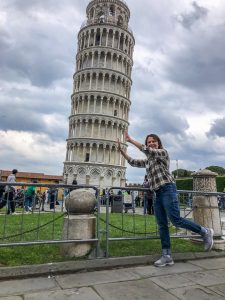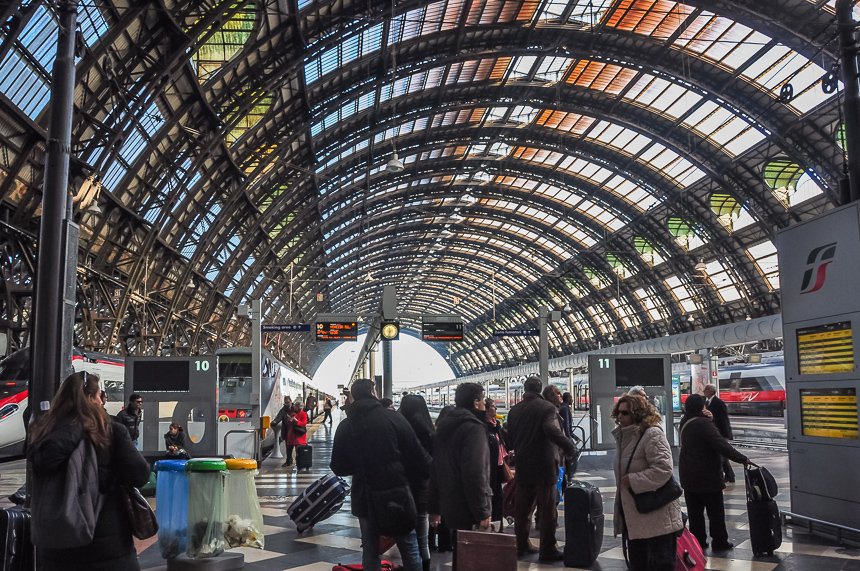
Saul Schwartz took his wife Fern by the hand and crossed the great pond for the first time since the pandemic on a mission to fall in love with Europe again. And what better place to rekindle that romance than in Northern Italy?
Milan, Florence, Pisa and Venice are all dreamy destinations and, if planned right, can be visited in less than 2 weeks. Saul and Fern left nothing to chance and had organized everything in advance.
What is the best way to spend a day in Pisa? Let them show you:

By Saul Schwartz
The Church of Santa Maria della Spina, located on Arno riverbank in Pisa, is like a little gem! Our walk from the train station to central Pisa took us past this scenic spot along the Arno River. The beautiful little church, which was not open to tour, is an extraordinary example of Pisan Gothic and was originally an oratory built in 1230.
Leaning Tower of Pisa

Advanced tickets for the Leaning Tower of Pisa are a must to avoid the line and guarantee admission. Tickets are available about one month before the date selected. We purchased the combination ticket which includes the Leaning Tower of Pisa, the Duomo Cathedral, the Baptistery, two museums and the monumental cemetery. The combo ticket provides a specific timed entry for the Tower of Pisa, but entry for any of the other attractions can be throughout the day. All sites are located close to the Piazza del Duomo and the Square of Miracles. Some of the ticket fees are used for restoration purposes.
We started off by taking pictures outside the iconic tower, clearly the city’s top attraction. Construction began in 1173 and continued over the course of 200 years. Because of unstable ground, the 60-meter-tall tower gradually began to lean to one side. The tower has 207 columns circling eight stories. We walked up 297 steps to the bell chamber at the top and from the bell tower, we had great views of Pisa. Work to stabilize the tower has been a success.
Pisa Cathedral

The magnificent Pisa Cathedral (Duomo) is an underrated attraction. The Cathedral is a masterpiece not to be overlooked. Work began on the large Roman Catholic Duomo in 1063. The exterior is a notable example of Romanesque architecture and the rich exterior decoration contains multicolored marble, mosaic, and numerous bronze objects. An elliptical dome was added in the 14th century and four impressive tiers of columns reach toward the heavens.
On a rainy day, the cathedral was a great, quiet option. The interior includes a Byzantine style mosaic in the apse, along with monolithic granite columns. The exquisite ceiling is decorated with gold leaf and carvings and includes the Medici family symbol. The dome features rich decorations. The marble pulpit showcases heroic figures. In addition, there is an enormous mosaic of Christ sitting on a throne between Mary and Saint John.
Pisa Baptistery of Saint John

Next to the Cathedral, the Pisa Baptistery of Saint John has a mix of the Gothic style with the Romanesque style. The circular marble building’s construction began in 1153, a dome was added in 1363 and it is the largest Baptistery in Italy and is even taller than the Leaning Tower!
The exterior is aligned with the adjoining Cathedral in terms of style, as they almost look like one building. Inside, there is a marble pulpit and a bronze sculpture of Saint John. There are not many decorations on either level.
Camposanto cemetary

We went on to the monumental cemetery which is called the Camposanto. This sacred burial ground was established in 1277 but was not completed until 1464. There is a field of holy land in between the buildings. Most interesting are the remains of colourful early frescoes on the walls with religious scenes.
Created in the 14th century, the subjects of the frescoes are a religious cycle of life and death. The exterior is well coordinated with the other buildings on the square. The cemetery also contains several interior chapels. Sculptures are part of almost every tomb.
Museums
Finally, we spent some time in the two museums (also included in the combination ticket price). On two floors, the Sinope Museum displays the preparatory drawings for the frescoes in the monumental cemetery. The Cathedral Museum contains some of the original works once contained in the Duomo, the Tower and the Baptistery. The courtyard of the Cathedral Museum is also a great location for taking pictures of the Tower from a quieter location.
We ended up having a very informal dinner and heading back to Florence by train. Fern and I felt that 3 days in Florence and one in Pisa allowed us enough time to get a flavour of Tuscany and to see many of its key attractions. Next, we head to Venice!
Getting there

The high-speed train from Florence to Pisa takes less than one hour. Although we purchased tickets in advance from Italia Rail, this regional route does not have reserved seats. We first walked about 20 minutes from central Florence to the Santa Maria Novella station.
On the way to the Florence train station, we stopped briefly at what is said to be the oldest pharmacy in the world, the Officina Profumo-Farmaceutica di Santa Maria Novella. There is no charge for admission to stop in and check out the beautiful fragrances, remedies, and herbal products. Established in 1221, the shop is just around the corner from the train station.
Upon arriving in Pisa Centrale train station, Fern and I walked another 20 minutes to central Pisa.
More info
About Saul Schwartz

Saul lives in Alexandria, Virginia and has lived in the Washington, D.C. area since 1984. He loves to travel throughout Europe with his wife and family and particularly enjoys interacting with local residents and learning about life in their city and country.
Saul has previously shared his travel insights with us. Check out his story about Touring Southwest Ireland – Limerick, Clare & Galway or read about his other adventures in Northern Italy: Adventures in Northern Italy: Milan and Adventures in Northern Italy: Florence.


